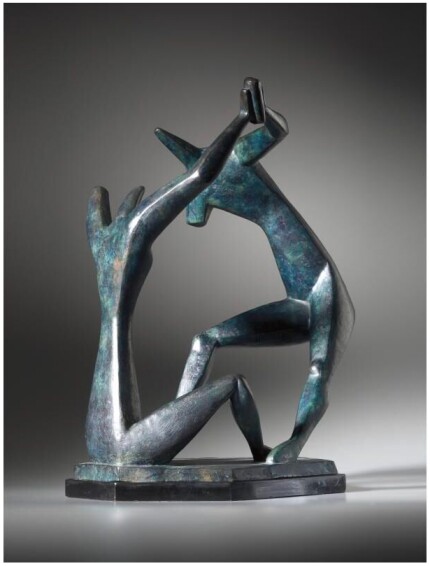- 46
Alexander Archipenko
Description
- Alexander Archipenko
- Large Dance
- Inscribed Archipenko, dated 1912 Paris, and inscribed © V2/S and numbered 2/8
- Bronze, blue-green-black patina
- Height: 29 1/8 in.
- 74 cm
Provenance
Perls Gallery, New York
Private Collection, United States (by 1986)
Literature
The Sketch, London, October 1913, illustration of the plaster on the cover
De Stijl, Amsterdam, January 1917, illustration of another cast p. 34
Roland Schacht, Archipenko, Berlin, 1923, discussed p. 16
Alexander Archipenko, Fifty Creative Years: 1908-1958, New York, 1960, illustration of another cast pl. 172
Alexander Archipenko, Rome, 1962, no. 7, the larger version listed
Giovanni Sangiorgi, “La Pittura scultorea di Archipenko,” Civiltà delle Macchine, Rome, September-October 1963, illustration of another cast p. 39
Donald Karshan, “Alexander Archipenko in Retrospect,” Journal of the Archives of American Art, Washington, D.C., April 1967, illustration of another cast p. 5
Frederick S. Wight, “Retrospective for Archipenko,”Art in America, New York, May-June 1967, illustration of another cast p. 66
Donald Karshan, “Archipenko,” Arts Magazine, New York, April 1968, illustration of another cast p. 37
Donald Karshan, Archipenko, International Visionary, Washington, D.C., 1969, no. 34, illustration of another cast pl. 22
Katherine Jánszky Michaelsen, Archipenko: A Study of the Early Works, 1908-1920, New York and London, 1977, no. S40, discussed p. 170
Georg-W. Kölzsch, Alexander Archipenko (exhibition catalogue), Moderne Galerie des Saarland-Museums, Saarbrücken, 1986, no. 13b, illustration of another cast of the larger version p. 35
Katherine Jánszky Michaelsen and Nehama Gurlnik, Alexander Archipenko: A Centennial Tribute (exhibition catalogue), National Gallery of Art, Washington, D.C.; Tel Aviv Museum, 1986, fig. 11, illustration of the plaster
Donald Karshan, Archipenko, Themes and Variations, 1908-1963, Daytona, 1989, illustration of the smaller version p. 53
Annette Barth, Alexander Archipenkos Plastisches Oeuvre, vol. 2., Frankfurt am Main, 1997, no. 44, illustration of the smaller version p. 99
Catalogue Note
Archipenko's Large Dance, also known as Dancers, boldly explores the relationship between form and space. The artist conceived a smaller version of this figural group in 1912 and exhibited the plaster cast in 1914 at Der Sturm, Herwath Walden's gallery in Berlin. According to Frances Archipenko Gray, the artist made three plasters of this sculpture which were used to cast the bronze editions. These consisted of one small plaster, one large plaster with a smooth surface, which is now in the Saarland Museum in Saarbrüken, and a large plaster with a rough surface. This large, rough-surfaced plaster, which was most likely destroyed during the casting process, was used to create three lifetime bronzes, including the present sculpture.
The composition of Large Dance bears a striking similarity in subject and in form to Matisse's painting, La Danse, painted in 1909-10, which Archipenko no doubt saw while living in Paris at this time. Executed with a more pronounced angularity than Matisse's early painting and incorporating the contemporary, Futurist notion of dynamism, the present work celebrates the body in motion and gives equal value to the space enclosed by the figures and the figures themselves.
Archipenko executed Large Dance in two different dimensions, one version in 1912 that was 24 1/2 inches in height and the other, modified about 1917, 29 1/2 inches in height respectively. The larger and later versions are inscribed Archipenko Paris.

